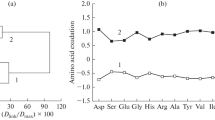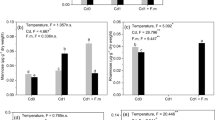Summary
The relationships between root exudation, root disease and anaerobic root stresses were investigated. Sand culture and mist chamber studies demonstrated that low O2 and high CO2 reduced plant growth and increased the exudation of ethanol, amino acids, and sugars by pea roots. The relative loss of ethanol by roots was much greater in treatments with atmospheres of N2 containing 30% CO2 than in treatments of air containing 30% CO2 or N2. Ethanol was not detected in the nutrient solution of aerated plant roots. Atmospheres of N2 plus 30% CO2 caused 500% greater mycelial growth ofFusarium solani f. sp.pisi and 400% more disease of inoculated pea roots. Relative losses of four amino acids and four sugars were much greater in atmospheres of N2 plus 30% CO2 than in N2 or air.
Similar content being viewed by others
References
Bolton E F and Erickson A E 1970 Ethanol concentration in tomato plants during soil flooding. Agron. J. 62, 220–224.
Chang C W and Bandurski R S 1964 Exocellular enzymes of corn roots. Plant Physiol. 39, 60–64.
Cochrane J Cet al. 1962 Spore germination and carbon metabolism in Fusarium solani. I. Requirements for spore germination. Phytopath. 53, 1155–1160.
Cossins E A 1964 Formulation and metabolism of lactic acid during germination of pea seedlings. Nature 203, 989–990.
Cossins E A and Turner E R 1962 Losses of alcohol and alcohol dehydrogenase activity in germinating seeds. Ann. Bot. 26, 591–597.
Crawford R M M 1967 Alcohol dehydrogenase activity in relation to flooding tolerance in roots. J. Exptl. Bot. 18, 458–464.
Durbin R D 1955 Straight-line function of growth of microorganisms at toxic levels of carbon dioxide. Science 121, 734–735.
Fulton J M and Erickson A E 1964 Relation between soil aeration and ethanol accumulation in xylem exudates of tomatoes. Soil Sci. Soc. Am. Proc. 29, 610–616.
Grable A R 1966 Soil aeration and plant growth. Adv. Agron. 18, 58–106.
Grable A R and Danielson R E 1965 Influence of CO2 on growth of corn and soybean seedlings. Soil Sci. Soc. Am. Proc. 29, 233–238.
Hale M G, Foy C L and Shay F J 1971 Factors affecting root exudation. Adv. Agron. 23, 89–109.
Kenefick D G 1962 Formation and elimination of ethanol in sugar beet roots. Plant Physiol. 37, 434–439.
Kramer P J 1969 Roots and root growth.In Plant and Soil Water Relations: A Modern Synthesis. pp 104–149.
Leonard O A and Pinckard J A 1946 Effect of various oxygen and carbon dioxide concentrations on cotton root development. Plant Physiol. 21, 18–36.
Lockwood J L 1962 A seedling test for evaluating resistance of pea to Fusarium root rot. Phytopath. 52, 557–559.
Miller D E and Burk P F 1975 Effect of soil aeration on Fusarium root rot of beans. Phytopath. 65, 519–523.
Papavizas G C and Davey C B 1962 Activity of Rhizoctonia in soil as affected by carbon dioxide. Phytopath. 52, 759–766.
Ponnamperuma F Net al. 1966 Influence of redox potential and partial pressure of carbon dioxide on pH values and the suspension effect of flooded soils. Soil Science 101, 421–431.
Rittenhouse R L and Hale M G 1971 Loss of organic compounds from roots. II. Effect of O2 and CO2 tension on release of sugars from peanut roots under axenic conditions. Plant and Soil 35, 311–321.
Rovira A D 1969 Plant root exudates. The Bot. Rev. 35, 35–57.
Schroth M N and Hildebrand D C 1964 Influence of plant exudates on root infecting fungi. Annu Rev. Phytopath. 2, 101–132.
Sherrod L L and Domsch K H 1970 The role of phenols and glycosidase in the pathogenicity mechanaism of Gliocladium categnulatum to roots of peas (Pisum sativum L). Soil Biol. Biochem. 2, 1974–2001.
Smith A M 1976 Ethylene in soil biology. Annu. Rev. Phytopath. 14, 53–73.
Smucker A J M 1984 Carbon utilization and losses by plant root systems.In Roots, Nutrient and Water Influx and Plant Growth. pp 27–46.
Smucker A J M and Erickson A E 1976 An aseptic mist chamber system: A method for measuring root processes of Pisum sativum L. Agron. J. 68, 59–62.
Walker J C and Hare W W 1943 Pea diseases in Wisconsin. Wisconsin Agr. Exp. St. Bull. 145. 32 p.
Author information
Authors and Affiliations
Rights and permissions
About this article
Cite this article
Smucker, A.J.M., Erickson, A.E. Anaerobic stimulation of root exudates and disease of peas. Plant Soil 99, 423–433 (1987). https://doi.org/10.1007/BF02370887
Received:
Accepted:
Issue Date:
DOI: https://doi.org/10.1007/BF02370887




